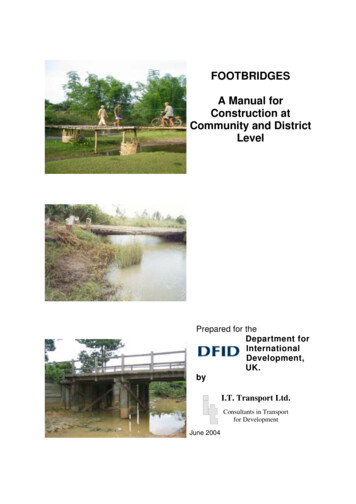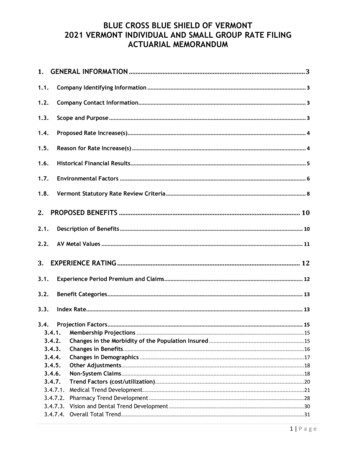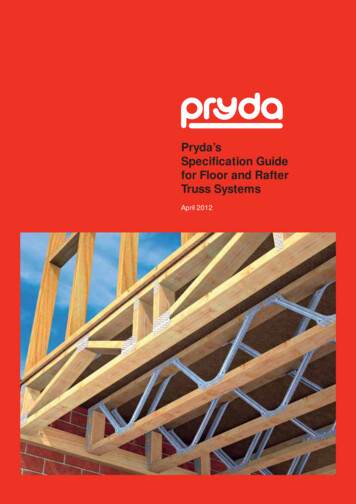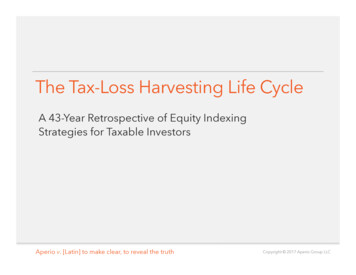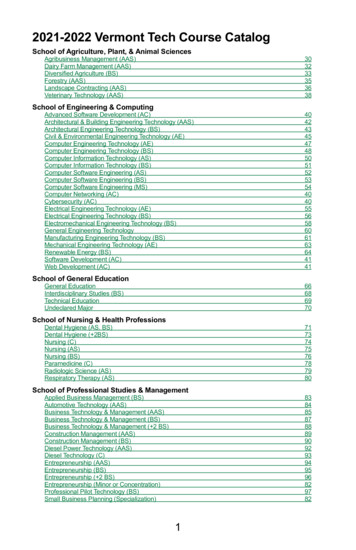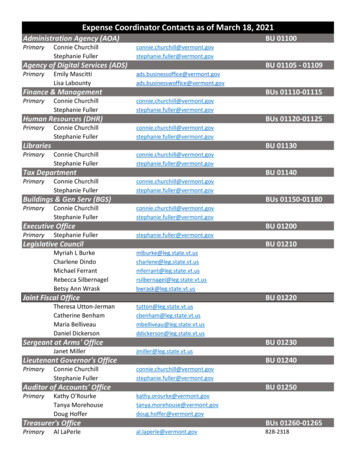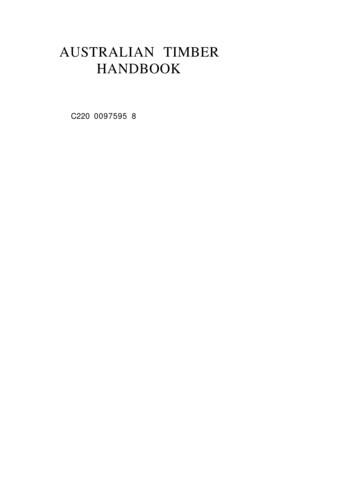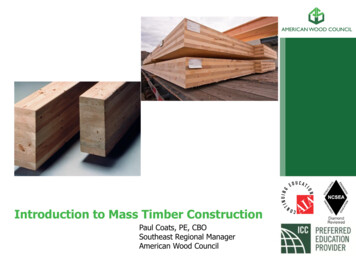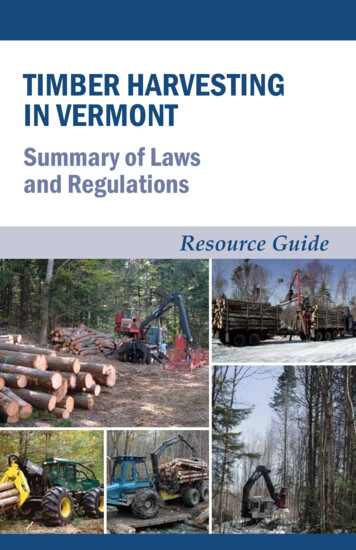
Transcription
TIMBER HARVESTINGIN VERMONTSummary of Lawsand RegulationsResource Guidephoto here
About This GuideThis Reference Guide provides a summary of laws andregulations affecting timber harvesting businesses in Vermont.While it is primarily intended for loggers and foresters, thereare others in forest industry who will find it helpful as well. Theguide provides an overview of laws and regulations pertaining totimber harvesting, trucking, human health and safety, taxes andbusiness management and insurance.The work is not a comprehensive explanation of laws pertainingto logging in Vermont, and readers are cautioned to not use it as acomplete and comprehensive representation of all pertinent lawsand regulations that affect timber harvesting. Thus it should nottake the place of other more detailed and specific sources, norshould it substitute for legal advice. Further explanations of laws,rules or regulations and how they might apply to a particularsituation should be addressed by the appropriate governingauthority (most of which are listed here), or with an opinion froman attorney.TIMBER HARVESTING IN VERMONT: RESOURCE GUIDE
TIMBER HARVESTINGIN VERMONTSummary of Lawsand RegulationsResource GuideHow to use this guideInformation has been broadly categorized into five chapters then subdividedby topic into sections. At the end of each section are listed pertinentpublications, laws, forms, and contact information for those who need moreinformation. Since rules and regulations are constantly changing, the ‘contact’information at the end of each section may serve as a starting point. In fact,readers should automatically assume that the information outlined here isslightly outdated. For this reason, an opinion from the appropriate governingauthority should precede commencement of any logging operations. When indoubt, always get an opinion from a knowledgeable source.TIMBER HARVESTING IN VERMONT: RESOURCE GUIDEi
Contents1 Timber HarvestingWater Quality 1Acceptable Management Practices (AMP’s)1Logging in Wetlands 2Alteration of Streams 3Discharge Permits 4Rubbish and Garbage 4Fire Prevention 5Slash Removal 5Forest Sustainability and Land Use6Act 250- Logging Above 2500 Feet6Heavy Cut 6Chip Harvesting Requirements for Public Utilities7Registration of Chip Harvesters7Timber Trespass 72 TruckingPermits 9Highway Permits 9Oversize Vehicle Permits 10Size Limits 10Height and Width Limits10Length limits 11Weight Limits 12Safety 12Brake Requirements 12-13Securing Loads 13Local Regulations 133 Human Health and SafetyLabor Standards 14Federal Fair Labor Standards14Worker Safety Standards 15Worker Safety and Health- VOSHA15OSHA Logging Safety Standards16Noise Regulations 17Hazardous Material 17Shop and Garage Practices17Hazardous Material Management17Oily Waste 18Waste Storage 18Used Oil 18Spill Response 18-19SPCC Regulations 19TIMBER HARVESTING IN VERMONT: RESOURCE GUIDEii
4 TaxesFederal Tax Information 20Federal Income Tax 20Federal Income Withholding Tax21Information Returns 21Timber Taxation 22Social Security 22-23Vermont Tax Information 23Vermont Income Tax WithholdingVermont Income Tax ReturnsVermont Corporate and Business Entity Income TaxVermont Business Tax Account NumberVermont Sales and Use Tax2324252526Landowner Tax Information 27Use Value Appraisal27Highway Vehicle Use Tax285 Business Management and InsuranceFederal Business Requirements29Vermont Business Requirements31Federal Insurance Requirements33Vermont Insurance Requirements33Required Records 29Employer Identification Number30Payments to Non-Employees 30Business Licenses 31Contracts for the Purchase of Timber31Buying and Selling Forest Products-32Weights and MeasurementsUnemployment Insurance 33Workers Compensation Insurance33-34Unemployment Insurance 35General Liability Insurance 35Appendix 36Federal Agencies 36State Government/Agencies 37Other Organizations 43TIMBER HARVESTING IN VERMONT: RESOURCE GUIDEiii
TIMBER HARVESTINGChapter 1Timber HarvestingThis chapter includes state laws, rules and regulations that any loggerworking in Vermont must know before conducting on-the-groundlogging operations. Many of these laws and permit requirementspertain to the protection of water quality as mandated by the FederalClean Water Act and Vermont’s Water Quality Statutes. Also includedare state laws pertaining to forest fire prevention, forest sustainabilityand land use. In all instances, the governing authority listed at theend of each section is the ultimate source of information.Water QualityAcceptable Management PracticesIn 1986, the Vermont Legislature passed amendments to Vermont’sWater Quality Statutes that declared: “It is the policy of the state to seekover the long term to upgrade the quality of waters and to reduce existing risksto water quality.” The law requires permits for the discharge of, “anywaste, substance or material into the waters of the state.” Permits, however,are not required when an inadvertent discharge results from a loggingoperation if the Acceptable Management Practices (AMP’s) are in place.The AMP’s are intended and designed to prevent any mud, petroleumproducts and woody debris (logging slash) from entering waters of thestate. They specifically address twenty-four suggested practices thatloggers and landowners can use to protect water quality and preventerosion, both during and immediately after logging.Both landowner and logger can be held liable when a non-permitteddischarge takes place if the AMP’s have not been followed. Suspectedviolations of AMP’s should be reported to the District Forestry Office(10 V.S.A. Chapter 47 § 1259 and 1275).Publications: Acceptable Management Practices for Maintaining WaterQuality on Logging Jobs in Vermont, 2006, Vermont Department of Forests,Parks and Recreation, ct: Vermont Department of Forests, Parks and Recreation Forestry Division, 802-241-3678, www.vtfpr.orgTIMBER HARVESTING IN VERMONT: RESOURCE GUIDE1
TIMBER HARVESTINGchapter 1Logging in Wetlands“Wetlands” include swamps, marshes, sloughs, potholes, floodplains,fens, beaver flowages, mud flats, and bogs. Depending upon their extentand significance, primarily for habitat, all wetlands are designated asClass One, Class Two, or Class Three according to the following scheme: Class One wetlands are considered exceptional or irreplaceable.Class Two wetlands are considered significant enough to beplaced under protection.Class Three wetlands are those that have been determined to notbe considered significant.According to the Vermont Wetlands Rules, silvicultural activitiesare allowed provided the configuration of a wetland’s outlet, or theflow of water into and out of the wetland, is not altered, and that nodraining, dredging, filling, or grading has occurred.All silvicultural activities must:A. Comply with AMPs;B. Comply with silvicultural standards for deer wintering yards,established jointly by the Departments of Fish and Wildlife,and Forests, Parks and Recreation, especially when occurringin significant wetlands or adjacent buffer zones containing deerwintering yards mapped by the Fish and Wildlife Department;C. Restrict equipment maintenance and the storing or changing ofoil, grease, or other petroleum products to log landings in areasoutside of wetlands; andD. Restrict log landings to uplands or buffer zones except thatlandings not requiring the placement of fill may be located withinthe wetland, but only when the ground is frozen (10 V.S.A.Chapter 47 §1259).Publications: Vermont Wetlands Rules, Amendments adopted July 16, 2010;Effective August 1, 2010; Vermont Significant Wetland Inventory act: Department of Environmental Conservation Wetlands Section,802-338-4879, www.vtwaterquality.org/wetlands.htmTIMBER HARVESTING IN VERMONT: RESOURCE GUIDE2
TIMBER HARVESTINGStream Alteration General PermitThe Stream Alteration General Permit applies to projects whichinvolve the fill or excavation of 10 cubic yards or more within the topof-bank to top-of-bank, cross-sectional limits of perennial streams. Thepurpose of this general permit is to ensure that all stream alterationactivities are regulated efficiently and effectively in accordance withthe requirements of 10 V.S.A. Chapter 41. Certain exemptions applyand do not require coverage under this general permit. Acceptedsilvicultural practices as defined by the Commissioner of Forests,Parks and Recreation is an exemption to this general permit.Projectexemption from coverage under this general permit does not relieveany person of the responsibility to comply with any and all otherapplicable federal, state, and local laws, regulations, and permits, andto obtain landowner permission if working on the lands of othersPublications: Stream Alteration General Permit effective date April18, 2011. http://www.vtwaterquality.org/rivers.htmContact: Contact information and assigned geographic areas forVermont Department of Environmental Conservation StreamAlteration Engineers can be found at: http://www.vtwaterquality.org/rivers.htmTIMBER HARVESTING IN VERMONT: RESOURCE GUIDE3
TIMBER HARVESTINGchapter 1Discharge PermitsVermont law states: “Any person who intends to discharge waste into thewaters of the state or who intends to discharge into an injection well or whointends to discharge into any publicly owned treatment works any wastewhich interferes with, passes through without treatment, or is otherwiseincompatible with that works or would have a substantial adverse effect on thatworks or on water quality shall make application to the secretary (Agency ofNatural Resources) for a discharge permit.” (10 V.S.A. Chapter 47 § 1263)Although silvicultural activities are exempt from permit, therecurrently exists three Storm Water Permits that may be required forsawmills, timber storage facilities and garages. These permits include: Permit 3-9015, Impervious Surface PermitPermit 3-9020, Construction General PermitPermit 3-9003, Multi-Sector General PermitReaders should check with the Vermont Department ofEnvironmental Conservation Small Business Compliance AssistanceProgram to determine if an operation requires permit(s).Contact: Vermont Department of Environmental Conservation SmallBusiness Compliance Assistance Program- Business ComplianceSpecialist, 802- 241-3745, www.anr.state.vt.us/dec/ead/sbcap/index.htmRubbish and GarbageAccording to Vermont State Statutes: “No person shall discharge anywaste, substance or material into waters of the state, nor shall any persondischarge any waste, substance or material into an injection well or dischargeinto a publicly owned treatment works any waste which interferes with, passesthrough without treatment, or is otherwise incompatible with those works orwould have a substantial adverse effect on those works or on water quality,without first obtaining a permit for that discharge from the secretary.” (24V.S.A. Chapter 61 § 2201) and (10 V.S.A. Chapter 47 § 1259)Contact: Vermont Department of Forests, Parks and Recreation Forestry Division, 802-241-3678, www.vtfpr.orgTIMBER HARVESTING IN VERMONT: RESOURCE GUIDE4
TIMBER HARVESTINGFire PreventionSlash RemovalThe unmerchantable portions of trees (leaves, twigs and branches) arecommonly referred to as ‘slash.’ As defined by Vermont law, slash is:“The residue left on the ground after timber cutting or after a storm, fire, orother event. Slash includes unused logs, uprooted stumps, broken or uprootedstems, branches, bark, [and other debris].”According to statute:a. A person may cut or cause to be cut forest growth only if all slashadjoining the right-of-way of any public highway, or the boundary linesof woodlots owned by adjoining property owners, is treated as follows:1. All slash shall be removed for a distance of 50 feet from the right-of-way of any public highway or from the boundary lines of woodlotsowned by adjoining property owners.2. All slash shall be removed for a distance of 100 feet from standingbuildings on adjoining property.b. Owners or operators of timber or woodlots shall leave the main loggingroads through cut-over areas free from slash so that tractors may passover these roads unobstructed in order to carry men and supplies andfirefighting equipment to fire suppression crews.c. If in the opinion of the town forest fire warden there is no fire hazard as aresult of a cutting, he may issue, upon request, a statement relieving theoperator of the conditions required in this section (10 V.S.A. Chapter 83§ 2648).Contact: Vermont Department of Forests, Parks and Recreation Forestry Division, 802-241-3678, www.vtfpr.orgTIMBER HARVESTING IN VERMONT: RESOURCE GUIDE5
TIMBER HARVESTINGchapter 1Forest Sustainability and Land UseAct 250 - Logging above 2500 Feet ElevationVermont’s land use law, known as ‘Act 250,’ requires a land usepermit for any logging operation over 2,500 feet elevation. Permitsare issued by the District Environmental Commissions. The LandUse Panel of the Natural Resources Board oversees the activitiesof the District Environmental Commissions. It also providesadministrative support and enforcement of Act 250 permits, andconducts rulemaking related to the provisions of Act 250. The Agencyof Natural Resources, Division of Regulatory Management and theAct 250 Review Board manages and coordinates staff review of allAct 250 applications, and it also provides comments to the DistrictEnvironmental Commissions (10 V.S.A. Chapter 151 § 6001 and 6081).Contact: Vermont Agency of Natural Resources - RegulatoryManagement and Act 250 Review,802-241-3615, www.anr.state.vt.us/site/html/RMAR.htmNatural Resources Board Act 250 District Environmental Commissions,802-828-3309, www.nrb.state.vt.usSee appendix for District Office contact information.Heavy CuttingThe Vermont Legislature passed in 1997, H.536 (Act 15) known asVermont’s “Heavy Cut” law to regulate heavy cutting/clear-cutting offorest lands. The Vermont Department of Forests, Parks and Recreationrequires ‘Intent to Cut Notification’ if a landowner plans to heavily cut 40or more acres in one treatment. The term “Heavy Cut” is defined as: “ aharvest leaving a residual stocking level of acceptable growing stock below theC-line, as defined by the United States Department of Agriculture silviculturalstocking guides for the applicable timber type.” (10 V.S.A. Chapter 83 § 2625)Intent to Cut Notification application forms are found on the web at www.vtfpr.org/watershed/cutproc.pdf, or contact your nearest DistrictForestry Office.Contact: Vermont Department of Forests, Parks and Recreation Forestry Division, 802-241-3678, www.vtfpr.orgTIMBER HARVESTING IN VERMONT: RESOURCE GUIDE6
TIMBER HARVESTINGChip Harvesting Requirements for Vermont Public UtilitiesWood-fueled electrical plants located in Vermont are required to obtainfuels from contractors that adhere to harvesting standards imposedby the Vermont Public Service Board. These same rules require forestowners who supply wood chips to these plants to obtain pre-harvestapproval from the Vermont Department of Fish and Wildlife. Thepurpose of this approval process is to protect deer wintering areas,significant wetlands, and the habitats of rare, threatened or endangeredspecies (30 V.S.A. Chapter 5 § 248).Contact: Vermont Fish and Wildlife Department,802-241-3700, www.vtfishandwildlife.com/index.cfmRegistration of Chip HarvestersThe Commissioner of Forests, Parks and Recreation may require theannual licensing and registration of portable sawmills, portable chipharvesters and any other portable forest product utilization systems.And the operator must comply with all requirements stipulated for theoperation of such equipment (10 V.S.A. Chapter 83 § 2623).Contact: Vermont Department of Forests, Parks and Recreation Forestry Division, 802-241-3678, www.vtfpr.orgTimber TrespassA new timber trespass law (Act 147) came into effect on July 1, 2010.The new law provides that a person who unlawfully cuts trees maybe assessed a civil penalty. The amount of the civil penalty is basedon the diameter of a tree or trees that are unlawfully cut, felled,destroyed, or substantially damaged. It requires a landowner whoauthorizes a timber harvest to clearly and accurately mark the harvestunit before the harvest begins and assigns a civil penalty of not lessthan 250.00 and not more than 1,000.00 to any landowner whosefailure to clearly and accurately mark a harvest unit results in theunlawful cutting of trees. The act exempts under certain conditionsthe agency of transportation, municipalities, authorized harvesters,railroads, and surveyors from penalties or liability for the unlawfulcutting of trees. It clarifies that a person injured by the unlawfulcutting of trees may recover the greater of treble damages or the civilpenalty for each tree. It allows a cause of action for damages to bebrought against a landowner whose failure to clearly and accuratelyTIMBER HARVESTING IN VERMONT: RESOURCE GUIDE7
TIMBER HARVESTINGmark the timber harvest results in damages to the property of anotherperson. Finally, the act provides that the unlawful cutting of trees andthe improper marking of harvest units is a judicial bureau offense (13V.S.A. Chapter 13 § 3601 – 3604).Contact: Vermont Department of Forests, Parks and Recreation Forestry Division, 802-241-3678, www.vtfpr.orgTIMBER HARVESTING IN VERMONT: RESOURCE GUIDE8
TRUCKINGchapter 2Chapter 2TruckingThere are numerous permits, limitations and requirements that affecttrucking in Vermont. Failure to comply with these rules may resultin fines and/or penalties. The Vermont Department of Motor Vehicles(DMV) is responsible for the enforcement of these regulations. Thevarious DMV divisions are listed at the end of each section for readersthat require clarification or further information.PermitsHighway PermitsAccording to Vermont statutes: “A Highway Permit must be obtainedfrom the Vermont Agency of Transportation before doing any work withinthe state highway right-of-way or doing work on adjacent property that willaffect drainage reaching the state highway right-of-way” (Highway PermitApplication Information, 2008). A complete application is requiredfor forest land access and for the construction or improvement ofdriveways that affect existing state rights-of-way.Municipalities may also require ‘curb cut permits’ if an existing curbmust be cut to allow entry onto a town road. It is always prudentfor logging contractors to assume that highway access will require apermit. Always check with the town clerk or town road commissionerto ensure a correct interpretation of all local highway regulations.Forms: Highway Permit Form TA-210, Vermont Agency ofTransportationContact: Vermont Agency of Transportation - Utilities and Permits Unit1-802-828-1222, www.aot.state.vt.us/default.aspLocal town clerk or town road commissionerTIMBER HARVESTING IN VERMONT: RESOURCE GUIDE9
TRUCKINGOversize Vehicle PermitsA person or corporation wanting to operate a vehicle in excess of theweight and size limits described below must submit an applicationfor an ‘oversize vehicle permit’. Such application is directed to thecommissioner of motor vehicles. The permit is not issued until proof ofregistration is provided and all fees are paid. Fees vary depending onvehicle size and number of trips. For the complete list of fee amountsand other information, refer to: 23 V.S.A. Chapter 13 § 1400-1402.Contact: Vermont Department of Motor Vehicles - Oversize andOverweight Permits Division, 1-802-828-2064Size LimitsHeight and Width LimitsVermont Motor Vehicles Laws specify all rules and requirements thatapply to vehicle size. No motor vehicle can exceed the dimensions of8.5 feet wide and 13.5 feet high (23 V.S.A. Chapter 13 § 1431).Contact: Vermont Department of Motor Vehicles - CommercialVehicle Enforcement Section, RCEMENTOverview.htmTIMBER HARVESTING IN VERMONT: RESOURCE GUIDE10
TRUCKINGchapter 2Length LimitsA motor vehicle cannot exceed 46 feet in length. If that vehicle is alsopulling a trailer, the distance between the kingpin of the trailer and thecenter of the rearmost axle cannot exceed a total of 43 feet.The state of Vermont has established a designated network of truckroads. Length requirements change depending on whether the truckis ‘in’ or ‘out’ of the network. To obtain a complete list of roads withinthe truck network, please see: V.S.A. Title 23, Chapter 13, Section1432, Subsection (c); or visit- uments/TruckNetworkMap.pdf for a map of Vermont’strucking network.If the overall length of a vehicle plus trailer does not exceed 72 feet,it is allowed to operate within the trucking network without permit.Those units that do not exceed 68 feet can operate on any road withouta permit. For units that exceed these length limits, special permits areavailable. (23 V.S.A. Chapter 13 § 1432)Form: Excess Length Permit ApplicationAvailable online ssLength.pdfContact: Vermont Department of Motor Vehicles - Commercial VehicleEnforcement Section, RCEMENTOverview.htmVermont Department of Motor Vehicles - Oversize and OverweightPermits Division, 1-802-828-2064Commissioner of Motor Vehicles, 1-802-828-2011TIMBER HARVESTING IN VERMONT: RESOURCE GUIDE11
TRUCKINGWeight LimitsIn Vermont, trucks are limited to a maximum 600 pounds per inch oftire width. For example, a tire with a 10-inch width may carry no morethan 6,000 pounds. A truck with 12 of these tires may carry no morethan 72,000 pounds.No vehicle may exceed the gross loaded weight of 80,000 poundsfor both interstate and state highways. However, a permit may beobtained for a 5-axle truck at 90,000 pounds and a 6-axle truck at 99,000pounds.On state highways, no single axle load can exceed 22,400 pounds. Notandem axle load can exceed 36,000 pounds.On interstate highways, no single axle load can exceed 20,000 pounds,and no tandem axle load can exceed 34,000 pounds.On Vermont town highways, there is a limit of 24,000 pounds. A townpermit is required by law for anything exceeding this limit.There are other factors to consider when determining maximum grossweight, especially factors having to do with bridge construction. For acomplete set of all weight regulations, contact the Vermont Departmentof Motor Vehicles (23 V.S.A. Chapter 13 § 1392).Special permits are available if overall vehicle weight is greater than thedesignated weights allowed.Form: Excess Weight/Dimension Permit ApplicationAvailable online at tact: Vermont Department of Motor Vehicles - Commercial VehicleEnforcement Section, RCEMENTOverview.htmSafetyBrake RequirementsMotor vehicles must have brakes on all wheels, and both hydraulicand manual means of deployment, such as a parking brake. Trailersweighing between 3,000 and 6,000 pounds gross weight must also havebrakes on all the wheels of at least one axle. For weights in excess of6,000 lbs., every wheel on all axles must have brakes. All trailers musthave emergency brakes that deploy automatically during an accidentalbreak-away from the towing vehicle. For specific guidelines onemergency brakes, please review: 23 V.S.A. Chapter 13 § 1307.TIMBER HARVESTING IN VERMONT: RESOURCE GUIDE12
TRUCKINGchapter 2Contact: Vermont Department of Motor Vehicles - Commercial VehicleEnforcement Section, RCEMENTOverview.htmSecuring LoadsA load of logs or wood products must be securely fastened to thevehicle. Each tier up to a maximum of five feet must be fastenedwith one binding of adequate strength (the statute requiresbindings to have a working load limit of 2,750 lbs. as certified by themanufacturer). A taller load up to 10 feet requires two such bindings,and all loads in excess of 10 feet must be secured with three bindings.All loose ends of bindings must be secured so as to not endangerother vehicles on the highway.When loads are transported in a box-type trailer with solid sides,the above rules on binding do not apply, provided the trailer is notloaded higher than its side-boards. (23 V.S.A. Chapter 13 § 1452)Contact: Vermont Department of Motor Vehicles - CommercialVehicle Enforcement Section, RCEMENTOverview.htmLocal RegulationsOn all highways in villages, towns and cities, the legal load size isthe same as on state highways, unless there are restrictions postedby local authorities. Municipalities may request weight limits thatare less than state highway limits, if there is a reasonable alternativeroute around the town. Before traveling town roads, contact the localmunicipality to find out if there are truck ordinances or regulationsrelated to the operation of overweight vehicles (23 V.S.A. Chapter 13§ 1393).Contact: Vermont Department of Motor Vehicles1-802-828-2000, www.aot.state.vt.us/DMVLocal town clerk or town road commissionerTIMBER HARVESTING IN VERMONT: RESOURCE GUIDE13
HUMAN HEALTH AND SAFETYChapter 3Human Health and SafetyFederal and state standards have been set to ensure the safetyof logging industry workers. Information has been provided toreduce the risk of injury and/or legal consequence. Hazardousmaterial requirements for shops and garages are included. Carefulconsideration of these standards and requirements is recommendedbefore the commencement of any logging operation. Please contactthe listed authority for questions or further explanation.Labor StandardsFederal Fair Labor StandardsThe Fair Labor Standards Act (1938) establishes minimum wages,minimum overtime pay rates, recordkeeping standards, and childlabor rules for all full-time and part-time employees. Due tooccupational hazards, people under the age of 18 are not allowed towork in most jobs in the logging industry.In July, 2008 the federal minimum wage was set at 6.55 per hour andis scheduled to increase to 7.25 per hour, effective July, 2009. But, asof January 1, 2011 Vermont’s minimum wage is 8.15 per hour andthis figure overrides the federal minimum wage.Finally, under federal rules, a pay rate of no less than one and onehalf times the regular rate of pay is required for any employee whoworks more than 40 hours in a workweek. Since both federal andstate rules regarding minimum wage change frequently, always checkwith the Vermont Department of Labor.Laws: Fair Labor Standards Act of 1938 (amended)Contact: U.S. Department of Labor - Employee StandardsAdministration1-866-4-USA-DOL (1-866-487-2365), www.dol.gov/esaTIMBER HARVESTING IN VERMONT: RESOURCE GUIDE14
HUMAN HEALTH AND SAFETYchapter 3Worker Safety StandardsWorker Safety and Health- VOSHAThe mission of the Vermont Occupational Safety and HealthAdministration (VOSHA) is to protect the health and safety ofour workers. VOSHA is comprised of two different sections: 1)Enforcement, that ensures Federal standards set by the OccupationalSafety and Health Administration (OSHA), are met by employers; and2) Project WorkSAFE, that offers employers assistance – at no charge –to help them meet current standards. For more information on ProjectWorkSAFE, call the Vermont Department of Labor-Safety and HealthConsultation at 1-888-SAFE-YES (1-888-723-3937).Employer and employee rights and responsibilities related to safetyand health are documented in the booklet listed below. As of 2008,the cost of the publication is 20 and can be ordered through theVermont Department of Labor.Publications: “VOSHA Safety and Health Standards for GeneralIndustry”, updated annually, VOSHA 802- 828-2765Contact: Vermont Department of Labor1-802-828-4000, www.labor.vermont.govTIMBER HARVESTING IN VERMONT: RESOURCE GUIDE15
HUMAN HEALTH AND SAFETYOSHA Logging Safety StandardsOSHA has promulgated rules and regulations intended to reduce riskand to increase safety during logging operations. These rules address,but are not limited to, the following areas: Personal protective equipmentFirst aid kitsFire extinguishersEnvironmental conditionsWork areasSignalingElectric linesFlammable liquidsExplosivesPortable power toolsMachine requirementsVehiclesTree harvestingTrainingWhen an on-site inspection determines that regulations are not beingfollowed, employers may be subject to fines depending on the severityof infractions. Noncompliance will result in increased penalties andmay lead to the termination of a business. Please refer to the OSHALogging Operations Regulations for a comprehensive review ofOSHA’s rule for safe logging. An electronic version is located at theweb site listed below.Publications: The Logger’s Guide to the New OSHA Logging SafetyStandards, 1995, Forest Resources Association INC.,www.osha.gov/pls/oshaweb/owadisp.show document?p id 1527&ptable DIRECTIVESContact: U.S. Department of Labor - Employee StandardsAdministration,1-866-4-USA-DOL (1-866-487-2365), www.dol.gov/esaVermont Department of Labor1-802-828-4000, www.labor.vermont.govTIMBER HARVESTING IN VERMONT: RESOURCE GUIDE16
HUMAN HEALTH AND SAFETYchapter 3Noise RegulationsOSHA’s Hearing Conservation Program requires employers tomonitor noise exposure levels at or above 85 decibels (dB) during an8-hour workday. When noise levels rise above permissible levels, theemployer must provide workers with protective equipment and offerfree hearing exams on a regular basis.For the sake of reference, the average noise level of selected loggingequipment is as follows: Working Chainsaw- 110 dBSkidder under load- 95 dBKnuckle boom loader- 85 dBPublications: Safety and Health Standards for General Industry, 29 CFR,Part Number 1910, Stan
timber harvesting, trucking, human health and safety, taxes and business management and insurance. The work is not a comprehensive explanation of laws pertaining to logging in Vermont, and readers are cautioned to not use it as a complete and comprehensive representation of all pertinent laws and regulations that affect timber harvesting.
